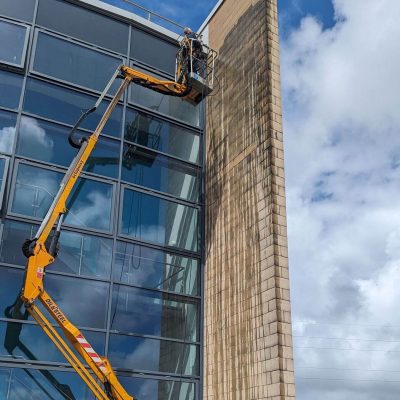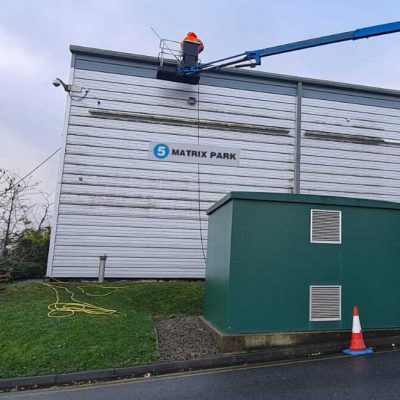Working at heights is a common requirement in many industries, from construction and maintenance to window cleaning and wind turbine operations. While physical safety measures are often emphasized, the psychological impact of working at elevated positions is frequently overlooked. Being far above the ground goes against our natural instincts. This can cause significant psychological stress.
Understanding these impacts is essential for anyone embarking on a career involving height work. This article examines the primary psychological challenges faced by workers at height and provides guidance on managing them.
Fear and Anxiety
The most common reaction to working at heights is fear and anxiety. Humans have evolved an innate fear of falling known as acrophobia. When at extreme elevations the brain signals danger, triggering physiological responses like sweaty palms, shaking legs, and a racing heart.
The severity varies by individual, but nearly everyone experiences heightened anxiety when first starting height work.
Prolonged exposure to anxious stimuli can cause
- excessive stress,
- fatigue, and
- risk of accidents.
Creating a plan to gradually acclimate to heights allows workers to build tolerance and manage fears. Starting with lower heights and working up while using fall protection builds confidence in gear and skills.
Talking through anxieties with experienced workers also helps normalise fear when starting out.
However, it is important to note that some apprehension at height is healthy and critical for safety. A complete absence of caution can lead to carelessness. Workers must find a balance where healthy respect for the risks exists without being overwhelmed by fear.
Isolation
Working at height frequently involves remote locations or limited space restricting movement. Wind turbines, communication towers, and exterior work on tall structures all involve operating in confined spaces far removed from other people.
Isolation from co-workers, friends, and family can exacerbate psychological challenges.
Humans are social creatures, and prolonged isolation is deeply problematic. It can manifest as depression, anxiety, irritability, and poor concentration which endanger the isolated worker.
Schedule regular communication with individuals on and off the job site to alleviate issues. Take full advantage of mobile technology to text and call loved ones when working alone aloft. Don’t underestimate the value of simple conversation in managing isolation.
Vertigo
Vertigo refers to sensations of spinning, swaying or tilting when looking down from heights. It is caused by a mismatch between visual cues and the vestibular system in the inner ear which controls balance.
Movement and visual stimuli at elevations trigger a feeling that the worker or environment is unstable. Vertigo can cause crippling nausea, loss of coordination, and direct danger of collapse or falls.
Ironically, the most effective treatment is repeated exposure and movement at heights. This trains the brain to integrate appropriate visual and vestibular cues and adapt. Take time when first reaching height to acclimate.
Move slowly and avoid sudden head movements. Over time, most workers adjust and vertigo subsides. Medications like antihistamines can temporarily reduce inner ear disturbances as well.
Mental Fatigue
Working safely at heights requires constant focus and vigilance. All movements and actions must be deliberate and controlled. A high level of alertness is essential even during mundane or repetitive tasks. Over a full shift, this intense concentration can result in mental fatigue.
Fatigue diminishes cognitive skills like
- decision making,
- reaction time,
- memory, and
- situational awareness.
This directly correlates with increased injuries and accidents. Rotating between heights work and ground-level tasks within a shift is an effective prevention.
Scheduling adequate downtime for rest between shifts is also critical. Establish routines that allow your mind and body to fully recover after bouts of intense focus.
Sense of Vulnerability
Precarious positions far above the ground create a profound sense of vulnerability. Survival inherently feels dependent on tools and equipment holding firm. This lack of direct control can create unease and apprehension at heights.
Even accessing a rooftop via an interior ladder can trigger vulnerability emerging into open space.
Training to use fall arrest, fall restraint, and descent control equipment breeds trust in your systems. Thorough inspection and maintenance ensure reliability.
But also acknowledge that vulnerability is part of the height environment.
Complacency
Surprisingly, one of the biggest psychological threats at height comes after acclimating and gaining experience. Once familiarity sets in, a natural tendency towards complacency follows.
A mindset emerges that “this is easy” or “nothing will happen to me”. False confidence breeds shortcuts, ignored protocols, and otherwise unnecessary risks.
Maintain vigilance against complacency through regular training, safety briefings, and enforcing rules. Take time to mentally reset yourself before each shift to stay alert. Embrace humility that you do not “control” the precarious heights environment.
Practise the same diligence even on your 1000th day at height as your first.
Fear of Falling
The most discussed and obvious psychological impact of height work is the fear of falling. It is so primal and universal that anxiety manifests physically with vertigo, trembling, nausea, and panic attacks in sufferers.
A difficult truth is that while equipment and training reduce risk, the actual danger of a fall is always present at extreme heights.
However, techniques do exist to manage fear and develop “nerves of steel” over time.
Frequent, gradual exposure trains both mind and body to function calmly at height. Simulated fall training in a controlled setting like a climbing gym acclimates you to the motions and equipment involved. Building confidence in your safety system is vital.
Hypervigilance
Hypervigilance is a state of over-alertness stemming from anxiety or trauma. Workers who survived a fall or lost colleagues may be prone to obsessive checking of gear, extremely slow movements, and refusal to work at certain heights.
While important for situational awareness, hypervigilance to the point of dysfunction indicates unresolved trauma.
Counselling should be provided in a non-judgmental manner. Gradually re-exposure to heights work under supervision can overcome the trauma response. Peer support from colleagues who have gone through similar experiences is also helpful.
Integrating back into heights work must balance addressing fears while avoiding putting the hypervigilant worker or others at risk.
Panic Attacks
Some individuals are prone to experience sudden, incapacitating panic attacks when working at heights. These involve surges of overwhelming anxiety, racing heart, difficulty breathing, and urge to desperately escape the situation.
Attacks can completely overwhelm rational thought and leave a worker frozen and unable to function safely.
If you have a history of panic attacks, be open with your employer and colleagues. Address triggers and early warning signs. Carry medication if prescribed. Use breathing exercises to cut off an attack early before reaching incapacitating levels.
Have procedures in place for safely getting off heights if one occurs. Accept that you may not be suited for the most extreme elevations if attacks persist.
Depersonalisation
Rarely, some individuals working at heights over extended time suffer episodes of depersonalisation. This psychological state makes them feel detached from their body and reality, as if they are in a dream. Typically triggered by anxiety, fatigue, or trauma, episodes at height are dangerous and require immediate assistance.
Depersonalisation should not be ignored or dismissed as mere vertigo or exhaustion. Consult a mental health professional for assessment.
Take time away from height work while addressing underlying causes. Grounding techniques can help manage symptoms in the moment. But frequent recurrences likely indicate a need for reassignment away from heights.
Overcoming Challenges
Working safely at heights requires mastering both physical skills and psychological readiness. Challenges like fear, isolation, and vertigo are part of the height environment. But through training, experience, and support of colleagues they can be overcome to carry out your duties productively.
Seek assistance from employers, mentors, and healthcare experts before struggles grow into larger issues. With time, the brain adapts and heights become just another workplace.
The exhilaration and satisfaction that comes from ascending skyscrapers, towers, and mountainous terrain drives many workers into these fields. Know that the psychological pressures are normal and surmountable.
You are engaging in work that constantly pushes the boundaries of human capability. Take pride in your ability to perform critical tasks far above the ground that most will never experience.



